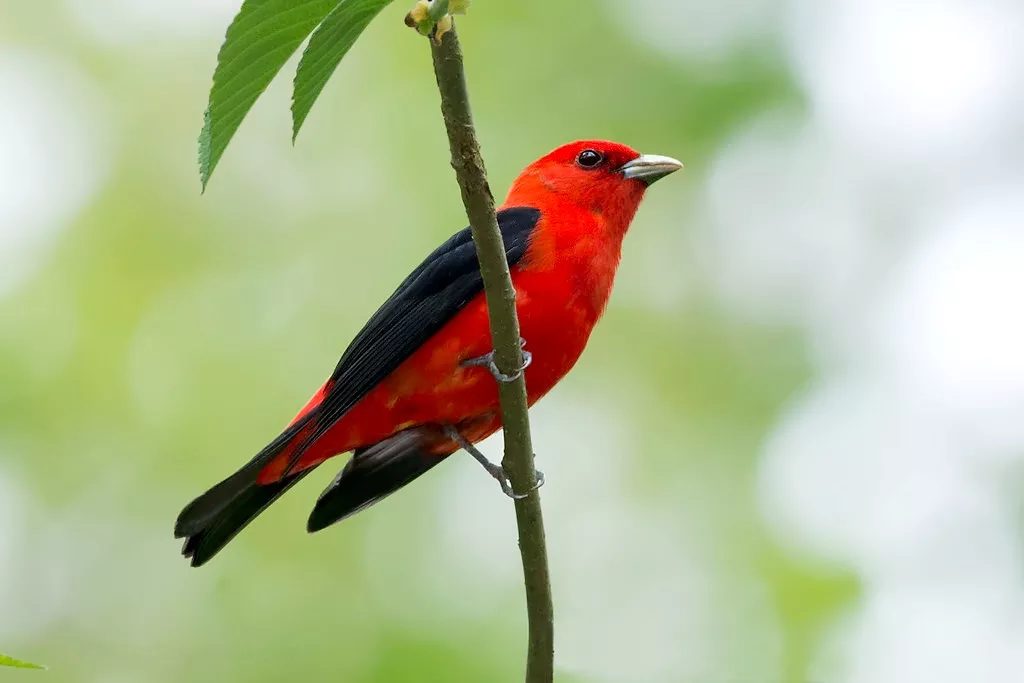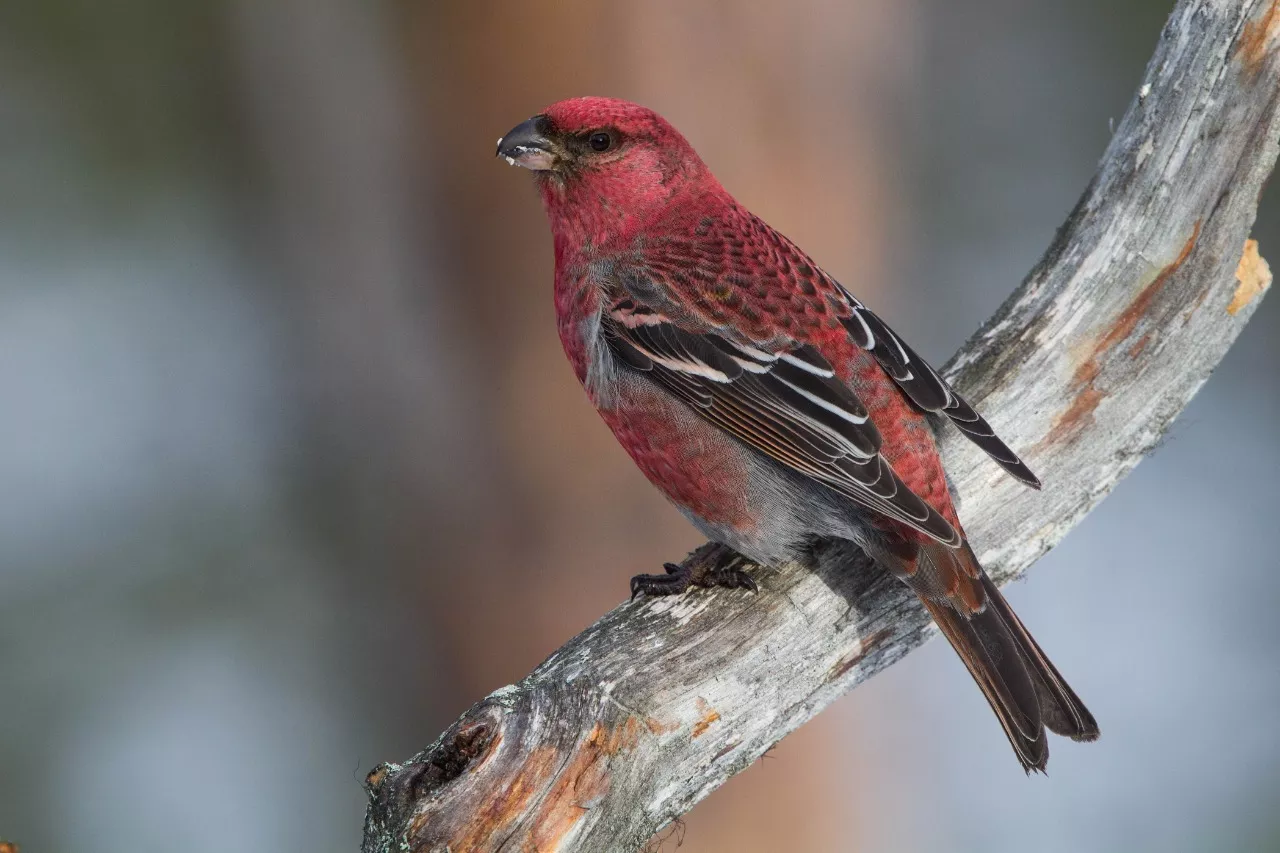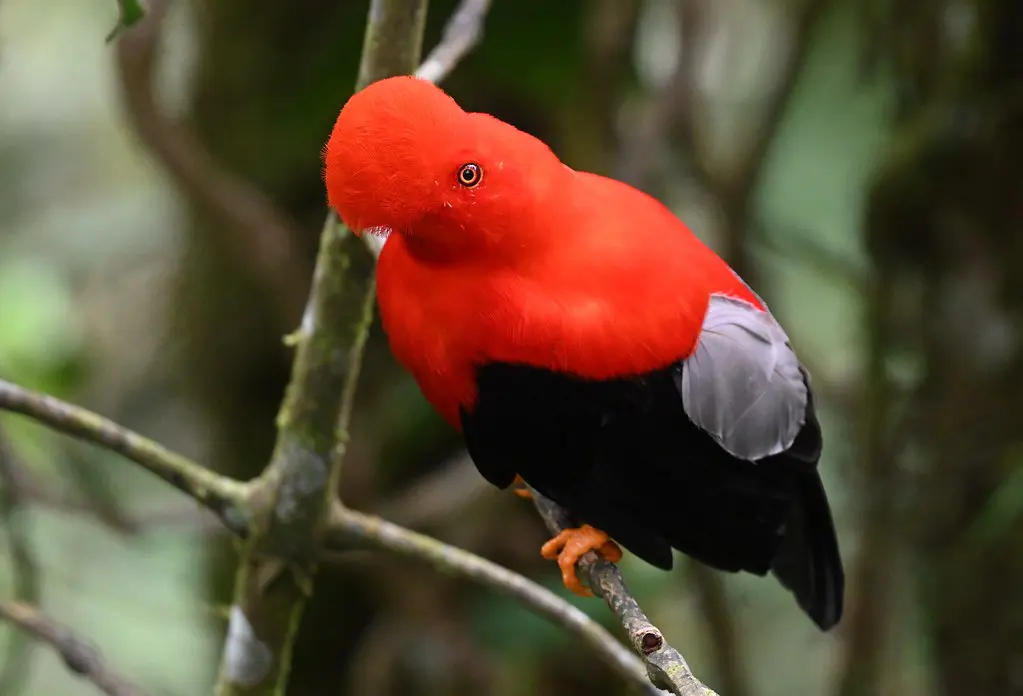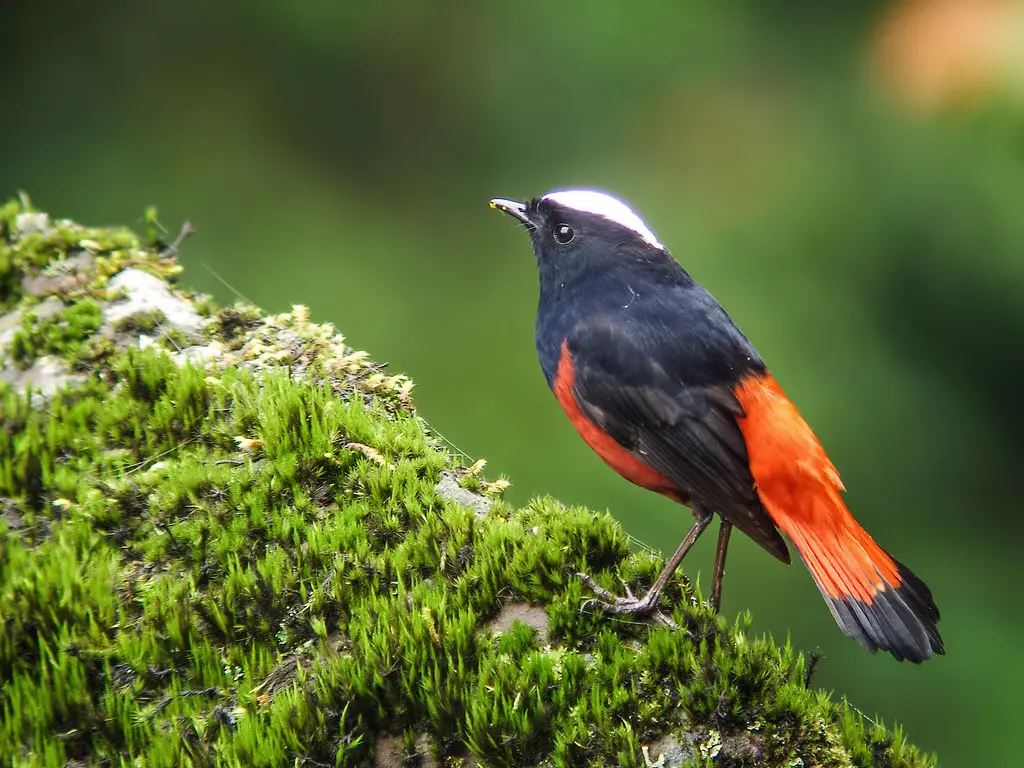Have you recently been captivated by a black-winged red bird in your backyard and wish to identify its species? Identifying red and black birds can be challenging, given the array of species fitting this description in North America. In this article, we will help you identify the bird you saw by focusing on the most common red birds with black wings. From the iconic Northern Cardinal with its crimson plumage and black wings to the vibrant Red-winged Blackbird, we will explore their distinct features and habitats. By the end, you will possess the knowledge to confidently recognize and appreciate these stunning avian creatures that grace our natural landscapes.
List of 11 Red Birds With Black Wings
- Scarlet Tanager
- Vermilion Flycatcher
- Pine Grosbeak
- Rose-breasted Grosbeak
- Masked Crimson Tanager
- Crimson-backed Tanager
- Brazilian Tanager
- Crimson Sunbird
- Andean Cock-of-the-Rock
- White-capped Redstart
- Black-winged Lory
Scarlet tanager

Image Source
- Scientific name: Piranga olivacea
- Life span: Up to 10 years
- Size: 18 cm (7.1 in)
- Weight: 22-28 g
- Origin: North, Central, and South America
The Scarlet Tanagers are stunning birds with eye-catching blood-red bodies and highly defined jet-black wings and tails that flash their magnificent plumage.
These songbirds live in deciduous woods and sit high in the forest canopy and mostly eat insects. They are difficult to see but their rich burrow songs may help in identifying them.
During the autumn, songbirds migrate to South America, changing their stunning red feathers into yellow-green ones.
Vermilion Flycatcher Male

Image Source
- Scientific name: Pyrocephalus rubinus
- Life span: Up to 8 years
- Size: 13 cm (5.1 in)
- Weight: 8-12 g
- Origin: North, Central, and South America
Male vermillion flycatchers are recognizable by their brilliant red feathers and grey wings. They also have a pointed black beak which is very different from the females who are predominantly grey with a slight trace of reddish color around their tail feathers.
These birds reside along streamsides, in drier more arid areas, savannahs, and ranches where they feed on little insects by hiding behind plants before springing out to capture the insects with their wings. they do also eat seeds and fruits however, little insects are the most abundant source of their diet.
These birds have a modest life in the wild, often surviving between 4 and 5 years, which isn’t all that lengthy, yet, like with most other birds, flycatchers are likely to live longer in captivity.
Pine Grosbeak

Image Source
- Scientific name: Pinicola enucleator
- Life span: Up to 10 years
- Size: 22-24 cm (8.7-9.4 in)
- Weight: 40-80 g
- Origin: Northern North America and Eurasia
Pine Grosbeaks are distinguished by their greyish-white wings and tail feathers, red body and head, and black beak and feet. Female grosbeaks are not nearly as colorful as males, having plumage that is mostly light grey with touches of orange around the body and tail.
Pine Grosbeaks spend most of their time in coniferous woodlands, where they may rest on a horizontal branch to hunt tiny insects, seeds, buds, berries, and other refreshing foods.
These birds have been observed to survive up to 9 years old, sometimes even longer, indicating that they have reasonably lengthy lifespans for birds of their size.
Masked Crimson Tanager

Image Source
- Scientific name: Ramphocelus nigrogularis
- Lifespan: Up to 7 years
- Size: Approximately 13-14 cm (5-5.5 inches)
- Native to: Central and South America
The Masked Crimson Tanager is a bright songbird found in Central and South America. This tanager species have striking plumage, with the male displaying a jet-black body, a vivid red mask reaching from its face to its neck, and contrasting white wing bars. The female has more muted coloring, with a grayish-black body and a less prominent mask.
Masked Crimson Tanagers occupy diverse wooded settings, including rainforests, woods, and gardens. They have a wide diet including of fruits, insects, and nectar, which they get by vigorously foraging in the treetops.
When it comes to their beautiful vocalizations, these tanagers generate a sequence of sweet whistling notes, frequently singing from a high perch to establish territory and attract mates. They are noted for their energetic and acrobatic flying displays during courting rituals.
Rose-breasted grosbeak (little bird with red chest)

Image Source
- Scientific name: Pheucticus ludovicianus
- Life span: Up to 8 years
- Size: 18 cm (7.1 in)
- Weight: 31-46 g
- Origin: North and Central America
These medium-sized birds of the cardinal family, are lovely to see. They may be seen all throughout the eastern coniferous woods, woodlands, and parks and sing cheery songs that are musical and have lovely whistling sounds.
The stout Rose-breasted Grosbeak has a jet-black head that extends all the way to the tail and a magnificent red patch that runs from the neck to the breast.
White feathers cover the remainder of the underbody, and the wings and tail have decorative white patches. The frolicking bird’s large conical beak stands out in the whole body.
The females, in contrast to the males, have overly golden streaks throughout their brownish plumage.
Crimson-backed Tanager

Image Source
- Scientific name: Ramphocelus dimidiatus
- Lifespan: Up to 7 years
- Size: Approximately 13-14 cm (5-5.5 inches)
- Native to: Central and South America
The Crimson-backed Tanager is a magnificent bird species found in Central and South America. Its name stems from the bright red hue of its back, contrasting with its black wings, tail, and head. The underparts of the male are brilliant black, while the female has a more muted olive-green plumage.
These tanagers occupy diverse wooded settings, including rainforests, woods, and gardens. They have a wide diet comprising of fruits, insects, and nectar, which they get by vigorously foraging in the canopy of trees.
The male Crimson-backed Tanager is recognized for its beautiful and intricate song, a sequence of high-pitched notes that reverberate through the forest. They utilize their vocalizations to create territories and attract partners during the breeding season.
Breeding couples make cup-shaped nests in the branches of trees, where the female deposits her eggs, and both parents take part in incubation and chick care.
Brazilian Tanager

Image Source
- Scientific name: Ramphocelus bresilius
- Lifespan: Up to 7 years
- Size: Approximately 13-15 cm (5-6 inches)
- Native to: Eastern and southeastern Brazil
The Brazilian Tanager is a beautiful songbird endemic to Brazil and other regions of South America. This medium-sized tanager stands out with its remarkable plumage, with a deep velvety black body and contrasting brilliant red plumage on its head and neck.
These tanagers are predominantly found in wooded settings, including rainforests and woods, where they forage for a wide diet of fruits, insects, and nectar. With their powerful beaks, they can readily shatter open seeds and retrieve their contents.
Male Brazilian Tanagers are recognized for their beautiful singing, which consists of a sequence of rich, musical notes. Their vocalizations are frequently heard booming across the forest as they defend their territory and attract mates during the mating season.
During courting, the male shows vivid plumage and participates in stunning aerial displays to entice possible mates. Breeding couples create cup-shaped nests in the thick foliage, where the female deposits her eggs, and both parents share incubation and chick-rearing tasks.
Crimson Sunbird

Image Source
- Scientific name: Aethopyga siparaja
- Lifespan: Up to 7 years
- Size: Approximately 11-13 cm (4-5 inches)
- Native to: Southeast Asia
The Crimson Sunbird is a beautiful little bird endemic to Southeast Asia. This sunbird species is properly called for the brilliant red plumage that covers its head, neck, breast, and upper parts, making a stunning contrast against its black wings and tail.
These sunbirds usually frequent wooded regions, gardens, and blooming bushes where they feed on nectar from different flowers. They have long, curved beaks well designed for drinking nectar, and they also supplement their diet with insects and spiders.
Male Crimson Sunbirds are famed for their stunning courting displays, during which they hover and flap their wings while singing sweet tunes. These displays are geared toward attracting females and defending their territory.
Females, on the other hand, feature more muted plumage with olive-green upperparts and yellow underparts. They serve a crucial role in creating cup-shaped nests composed of plant fibers, moss, and spider silk, where they deposit their eggs and care for their young.
Andean Cock-of-the-Rock

Image Source
- Scientific name: Rupicola peruvianus
- Lifespan: Up to 20 years
- Size: Approximately 33-38 cm (13-15 inches)
- Native to: Andean cloud forests in South America
The Andean Cock-of-the-Rock is a beautiful bird species that inhabit the cloud forests of the Andean area in South America. This bird is noted for its bright plumage and distinctive courting antics.
The male Andean Cock-of-the-Rock is a sight to see, with its vivid orange plumage, big crested head, and distinctive fan-shaped tail. During the mating season, males assemble at communal display places called leks, where they compete for the attention of females. They execute elaborate performances, jumping, bowing, and expanding their wings to reveal their brilliant feathers.
Females, in comparison, have more muted plumage, with brownish tones and a shorter crest. They carefully pick partners based on the males’ displays and general fitness.
These birds typically graze on fruits, insects, and tiny vertebrates, utilizing their sharp beaks to devour their diversified diet. They are significant seed dispersers in their forest environments.
White-capped Redstart

Image Source
- Scientific name: Myioborus fulvivertex
- Lifespan: Up to 8 years
- Size: Approximately 11-12 cm (4-5 inches)
- Native to: Western Mexico
The White-capped Redstart is a lovely songbird that may be found in the high-altitude woods of Central and South America. This little passerine is recognized for its stunning plumage and energetic activity.
The White-capped Redstart displays a jet-black body with a striking white cap on its head, providing a strong contrast. Its wings and tail also emit flashes of white, which become noticeable during flying.
These redstarts are incredibly active and nimble, continually hopping and darting between branches and tree trunks in pursuit of insects and spiders. Their thin beaks are well adapted for grabbing their prey.
Males and females of this species have a similar look, however, the female may have somewhat duller colors. They typically join mixed-species foraging groups, traveling through the forest in search of food.
Black-winged Lory

Image Source
- Scientific name: Eos cyanogenia
- Lifespan: Up to 20 years
- Size: Approximately 30-32 cm (12-13 inches)
- Native to: Indonesia
The Black-winged Lory is a magnificent parrot species unique to the islands of Indonesia. This medium-sized lory sticks out with its bright plumage and unique black wings.
The Black-winged Lory boasts a deep blue body, with a brilliant red head, chest, and upper belly. Its wings are mostly black, with flashes of blue and yellow visible during flying. These lovely hues make it a widely sought-after bird among avian aficionados.
These insects frequent tropical rainforests and lowland woodlands, where they eat nectar, pollen, fruits, and seeds. With their unique brush-like tongues, they gather nectar from flowers, making them vital pollinators in their environments.
Known for their sociable behavior, Black-winged Lorries are generally encountered in small groups, conversing with a range of screeches, whistles, and squawks. They are adept flyers, rapidly moving across the woodland canopy.
Final Thoughts on Red Birds With Black Wings
Through our exploration of the most common species of Red Birds With Black wings in North America, we have uncovered the beauty and diversity of these remarkable birds. From the iconic Scarlet tanger with its vibrant red plumage and contrasting black wings to the striking Crimson Sunbird, each species holds its own charm and allure.
Next time you spot a flash of red with contrasting black wings, take a moment to marvel at the splendor of nature and the intricate beauty of these magnificent creatures. May these encounters inspire a greater connection to the natural world and a desire to continue exploring the wonders of avian diversity.
Embrace the enchantment of red birds with black wings, and let their presence remind us of the profound interconnectedness and awe-inspiring beauty of our planet’s wildlife.





![7 Beautiful Red Birds in Mississippi [Images + IDs]](https://birdsology.com/wp-content/uploads/2023/03/45-19-600x400.jpg.webp)